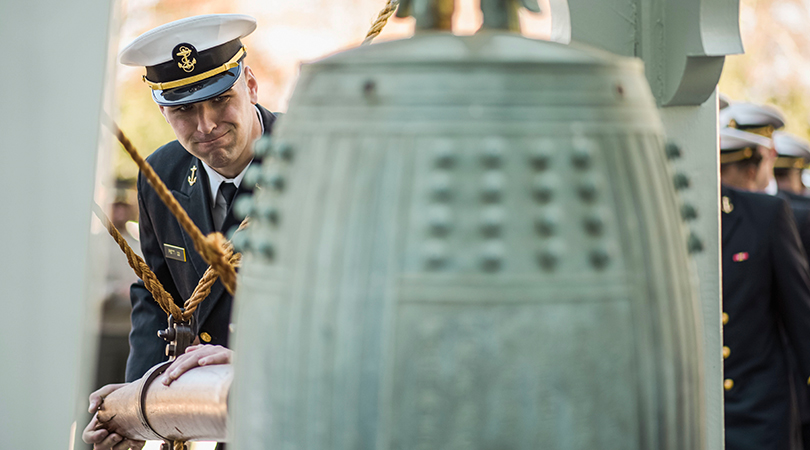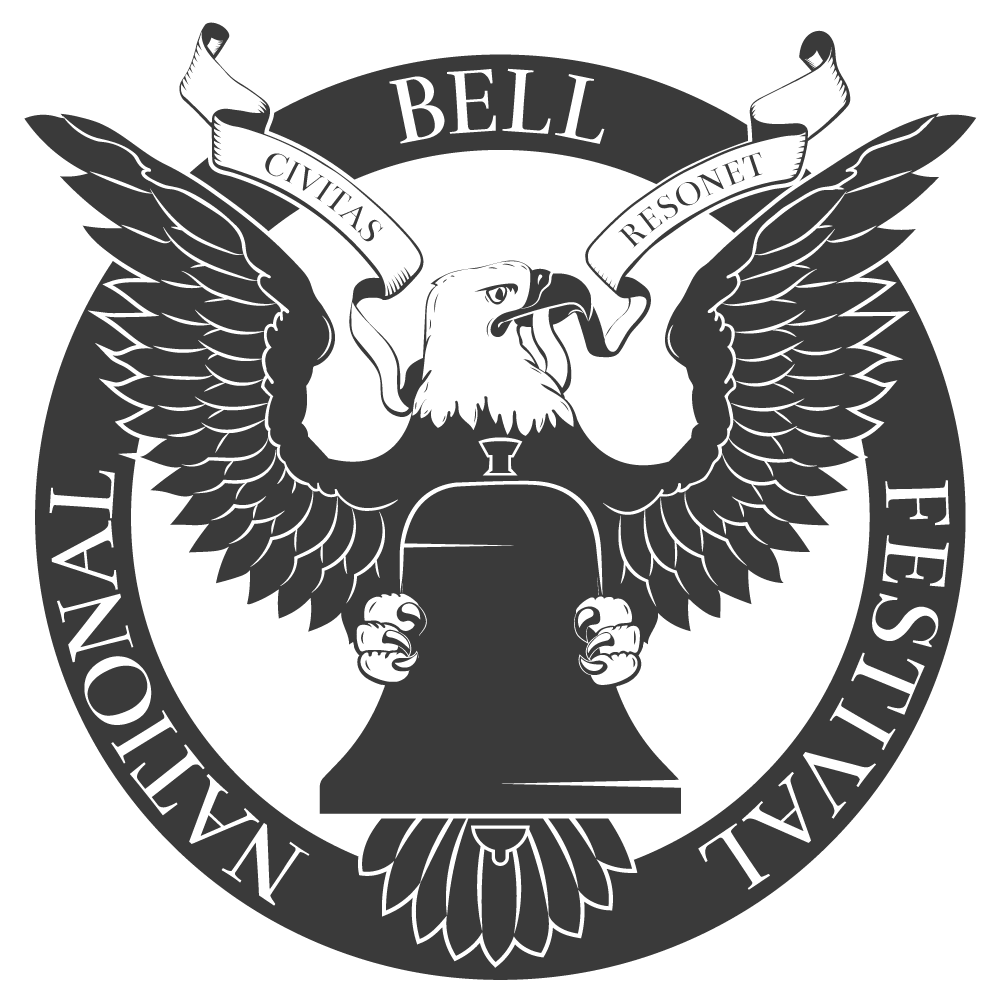The U.S. Naval Academy in Annapolis, Maryland – known as the Yard since the Revolutionary War (originating from ‘dockyard’) – is steeped in tradition and brimming with historical artifacts. Astride the steps of Bancroft Hall, the largest dormitory in the United States, sit two such relics in pride of place. These are the Enterprise Bell and the Japanese Bell, and they ring to life toward the end of each semester to celebrate sporting victories over Army.

Image: A U.S. Naval Academy Midshipman walks towards Bancroft Hall between class periods. The building is named in honor of George Bancroft, the Secretary of the Navy from 1845-1946 who is considered the founder of the Naval Academy. The dormitory is home to over 4,000 Midshipmen and encompasses 33 acres of floor space and 4.8 miles of corridors. Courtesy: Petty Officer 2nd Class Chadwick Runge, U.S. Navy.*
The two bronze bells, also called the Victory Bells, are heavy with histories of their own. To the right as you face Bancroft Hall hangs the Enterprise Bell. Originally serving on the bridge of the World War II aircraft carrier USS Enterprise (CV-6), the ship’s bell was brought to the Yard by Admiral Harry W. Hill in 1950.
A history of the Japanese Bell at the U.S. Naval Academy
Across the steps and to the left of the main entrance to Bancroft Hall hangs a replica of the Dai-Anzen-Ji temple bell. The original was cast in Japan in 1456 and presented to Commodore Matthew C. Perry by the regent of the now-named Ryukyu Islands, which include Okinawa. A translation of the Japanese inscription on the bell reads:
This beautiful bell has been founded and hung in the tower of the temple. It will awaken dreams of superstition. If one will bear in mind to act rightly and truly, and the lords and ministers will do justice in a body, the barbarians will never come to invade. The sound of the bell will convey the virtue of Fushi, and will echo like the song of Tsuirai, and benevolence of the lords will continue forever like these echoes.
Commodore Perry brought the bell back to the United States in 1854 and, in accordance with his wishes, it was presented to the U.S. Naval Academy by his widow on January 12, 1859, nine months after his passing. The bell was installed in a freestanding belfry near the superintendent’s residence on the Yard’s parade grounds. A smaller bell cast in a Western profile joined the Japanese bell in this structure.
In 1900, a new tradition was born: The captain of the football team rang the bell 11 times, signifying the points scored by Navy in its victory over Army. The ceremony was repeated for subsequent games, using a striker fashioned from wooden pews in the Academy’s second chapel. In 1945, the bell was struck with bowling pins from the old Bancroft Hall bowling alley to celebrate Victory over Japan Day. In 1956, the governor of Okinawa presented the U.S. Navy with an authentic Japanese shu-moku to sound the bell.

Image: The Dai-Anzen-Ji temple bell (right) and a bell cast in a Western profile in the belfry at the U.S. Naval Academy in Annapolis, Maryland, in 1860. Courtesy: Nimitz Library, U.S. Naval Academy.

Image: A Midshipman sits with a woman beneath the Dai-Anzen-Ji temple bell at the U.S. Naval Academy in Annapolis, Maryland, circa 1902. Courtesy: Library of Congress.

Image: A Midshipman strikes the Dai-Anzen-Ji temple bell at the U.S. Naval Academy in Annapolis, Maryland, in 1934 or 1935. Courtesy: Library of Congress.

Image: Midshipmen celebrate news of Imperial Japan's surrender by striking the Dai-Anzen-Ji temple bell with bowling pins on August 14, 1945. Courtesy: Nimitz Library, U.S. Naval Academy.
At the request of a later governor of Okinawa, the bell was repatriated to Japan on July 6, 1987, by order of the Secretary of the Navy James H. Webb, Jr. The secretary personally oversaw the bells return during a tour of the Pacific. It is now on display in the Okinawa Prefectural Museum. A replica of the nearly 600-year-old bell was hung back at the Yard in its stead.
When to ring the Japanese Bell
Bell ringing ceremonies are a U.S. Naval Academy tradition and both Victory Bells give service at moments of Navy pride. The Enterprise Bell is rung after most games when Navy prevails over Army in any one of the three sports seasons. Both bells are sounded in the autumn semester the Monday following any varsity Army-Navy wins. In the event of inclement weather, the ceremony may be rescheduled.

Image: U.S. Naval Academy Midshipmen and staff participate in the bell ringing ceremony at the U.S. Naval Academy in Annapolis, Maryland, on Dec. 13, 2021. Courtesy: Midshipman 4th Class Jarrod Schad, U.S. Navy.*
The Japanese Bell is sounded the number of times equal to the point spread for any given match. If a game ends with a Navy victory of 10-7, the bell is sounded three times by a series of people in this order: football team captain(s), head coach, superintendent, commandant, and athletic director. Then, every football team member may sound the bell one time each.
All ceremonies are facilitated by the Midshipmen Activities Officer and coordinated by the Brigade's Midshipman Operations Officer. For bell ringing guidelines, including example ceremony scripts and layouts, see Commandant of Midshipmen Instruction 5400.7E issued by the Department of the Navy.
Cover image: U.S. Naval Academy Midshipmen and staff participate in the bell ringing ceremony in T-court, which recognizes the varsity sports that defeated Army during the fall semester. A representative from each of those sports rings the bell, along with Superintendent Vice Adm. Sean Buck, Commandant of Midshipmen Col. James McDonough, and athletic director Chet Gladchuk, in Annapolis, Maryland, on Dec. 13, 2021. Courtesy: Midshipman 4th Class Jarrod Schad, U.S. Navy.*
*The appearance of U.S. Department of Defense (DoD) visual information does not imply or constitute DoD endorsement.



